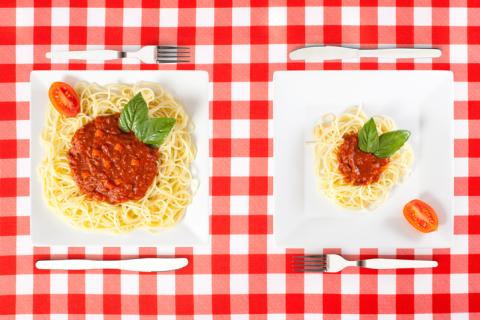“Portion Distortion” Can Pack on the Pounds
When tourists from other countries visit the U.S., they are often surprised by the size of portions in restaurants. In many countries, it is considered rude to ask for a “doggie bag.” That is partly a difference in custom, but it’s also because restaurants in our country tend to serve huge portions, more than a person could possibly eat in one sitting … or could they? The psychology of seeing food on our plate might lead us to eat the whole overly ample meal. And this, say experts, is one of the causes of “portion creep,” which has also contributed to the upward creep in the average weight of Americans—to a degree that is dangerous to our health.
Multiple studies have shown that diners report feeling full when they’ve finished their meal, even if it’s a modest amount … but they still feel hungry if they haven’t cleaned up their plate. Explains Tufts University Human Nutrition Research Center expert Susan B. Roberts, Ph.D., “Although in theory we don’t have to eat the whole lot, in practice most of us don’t have enough willpower to stop eating when we have had enough.”
Portion creep has also made its way into our homes. For one thing, the size of our dinner plates, bowls and utensils are larger than they used to be. If you inherited your grandmother’s china, it might seem miniature compared to patterns sold in stores today. A study from the University of Cambridge noted that using smaller tableware could help Americans cut back on the amount of food they eat by 29 percent! Cornell University researchers say an optical illusion is partly to blame (learn more here). Try using the dessert plate instead of the dinner plate for regular meals.
Here are five other tips to recalibrate our food portion sense:
Resign from the clean plate club. Gastroenterologists assure us that we can’t “shrink” our stomach, but we can reset our appetites. Start with a smaller serving, and then take your cues from how your body feels, not what you see on your plate. Wait a few minutes before going back for seconds; it takes a little while for your brain to get the message that you’ve eaten your fill. Generational norms may make it especially challenging for older adults to leave food on their plate, but remember—putting unwanted food in the compost or garbage disposal is no more wasteful than stuffing yourself and harming your health.
Check out visual aids. In order to avoid overeating and/or wasting food, develop a better sense of how much food you need. Want a graphic demonstration of “portion distortion”? The National Heart, Lung, and Blood Institute (NHLBI) offers a free online tutorial to help diners rethink the amount of food they should be eating. You can view it in PDF format, or show it to the whole family as a PowerPoint presentation.
Learn what a “serving” really is. As we’re thinking about consuming a healthier diet, we might research dietary recommendations. But how much of a given food equals a “serving”? On packaged foods, you can get a pretty good idea by seeing how many servings are in the container. You can also find serving size guidelines from the NHLBI and the American Heart Association.
Fall in love with leftovers. Most recipes are intended for four servings or more. If you’re only preparing the meal for yourself or perhaps one other person, plan ahead of time to have the dish make an encore the next day. Divide it in half and refrigerate half right away. Many dishes are even more flavorful the next day as the flavors mingle and richen. And instead of spending an hour cooking the next day, pop your meal in the microwave and go for a walk!
Go ahead and ask for that doggie bag. Some fine dining establishments serve sensible portions of food, but family-style places and many ethnic eateries these days really pile on the food. Most are happy to box up what’s left. Better yet, ask for the box at the beginning of the meal and divide everything in half. You’ll walk out feeling less bloated, and you’ll have a nice lunch for the next day.
